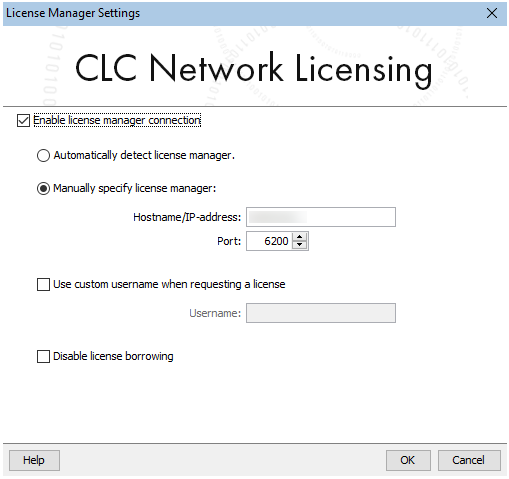Configure license manager connection
If your organization is running a CLC Network License Manager, you can configure your Workbench to connect to it to get a license.
To configure a Workbench to connect to a CLC Network License Manager, select the Configure license manager connection option and click on the Next button. A dialog appears, as shown in figure 1.15.

Figure 1.15: Configuring the connection to a CLC Network License Manager.
The options in that dialog are:
- Enable license manager connection. This box must be checked for the Workbench is to contact the CLC Network License Manager to get a license for the CLC Genomics Workbench.
- Automatically detect license manager. By checking this option the Workbench will look for a CLC Network License Manager accessible from the Workbench. Automatic server discovery sends UDP broadcasts from the Workbench on port 6200. Available license servers respond to the broadcast. The Workbench then uses TCP communication for to get a license, if one is available. Automatic server discovery works only on local networks and will not work on WAN or VPN connections. Automatic server discovery is not guaranteed to work on all networks. If you are working on an enterprise network on where local firewalls or routers cut off UDP broadcast traffic, then you may need to configure the details of the CLC Network License Manager using the Manually specify license manager option instead.
- Manually specify license manager.
Select this option to enter the details of the machine the CLC Network License Manager is running on, specifically:
- Host name. The address of the machine the CLC Network License Manager is running on.
- Port. The port used by the CLC Network License Manager to receive requests.
- Use custom username when requesting a license. Optional. When unchecked (the default), the username of the account being used to run the Workbench is the username used when contacting the license manager. When this option is checked, a different username can be entered for that purpose. Note that borrowing licenses is not supported with custom usernames.
- Disable license borrowing on this computer. Check this box if users of this machine should not be able to borrow a network license, e.g. for offline use.
Releasing Workbench network licenses
Once a network license for a CLC Workbench has been obtained, the Workbench must be shut down to release that license for others to use. While it is possible for a license to be pulled from a running Workbench, in practice, that Workbench will immediately retrieve the license just released.
Modules and network licenses
A relevant license is needed to run tools delivered by modules, and to submit jobs to be run on the cloud via a CLC Workbench.
To maximize availability, module licenses are first checked out when a job requiring the module is undertaken. Module licenses are checked back in (returned) when the CLC Workbench is closed, or four hours after the most recent job requiring that license was launched, whichever is shortest.
Job completion does not depend on the CLC Workbench having a module license checked out.
A note about borrowing module licenses: If you plan to borrow network module licenses and the CLC Network License Manager will not be continuously accessible from the CLC Workbench, then while there is still a connection, launch a job that requires the relevant module. If available, the relevant license will be checked out, and can then be borrowed. When a module license is borrowed, the four hour validity period mentioned above is not relevant. The module licenses are borrowed for the time period that you specify.
See Borrowing a license for further information about borrowing a license.
Subsections
